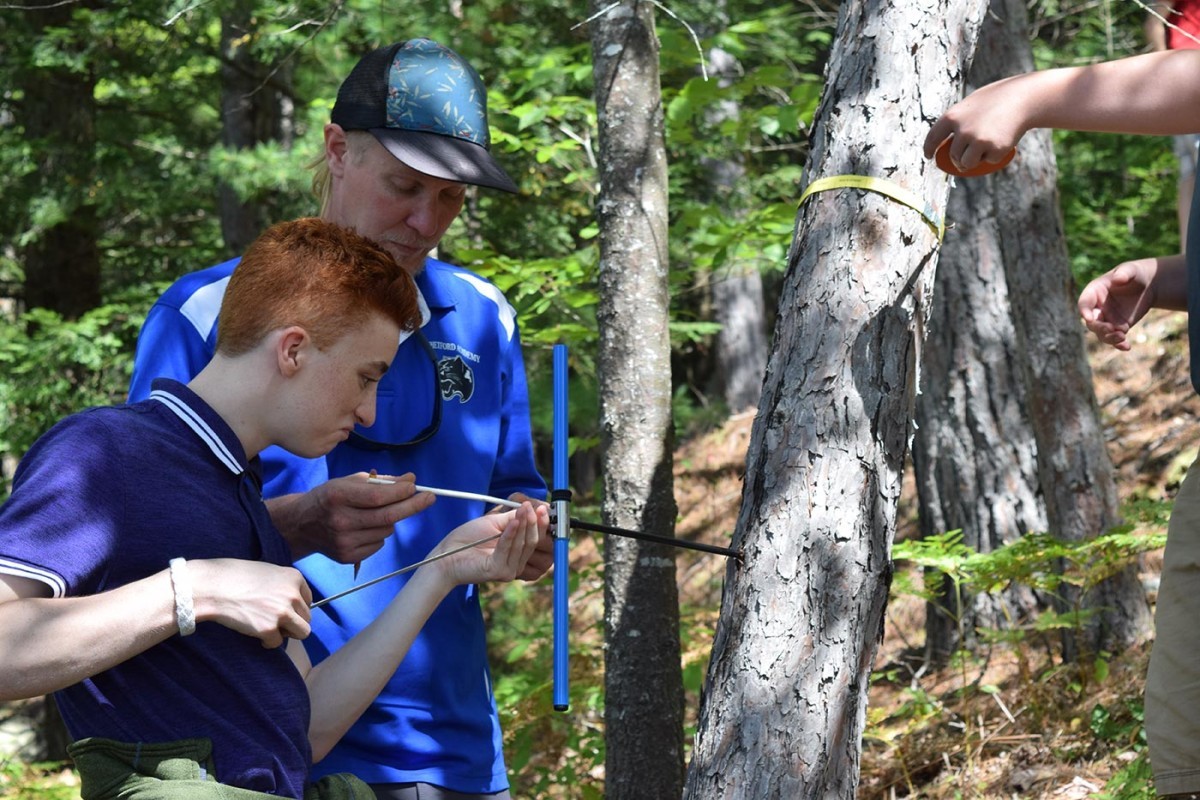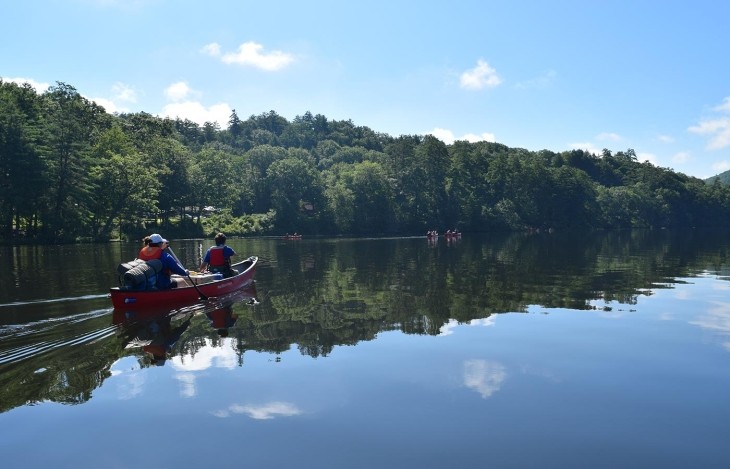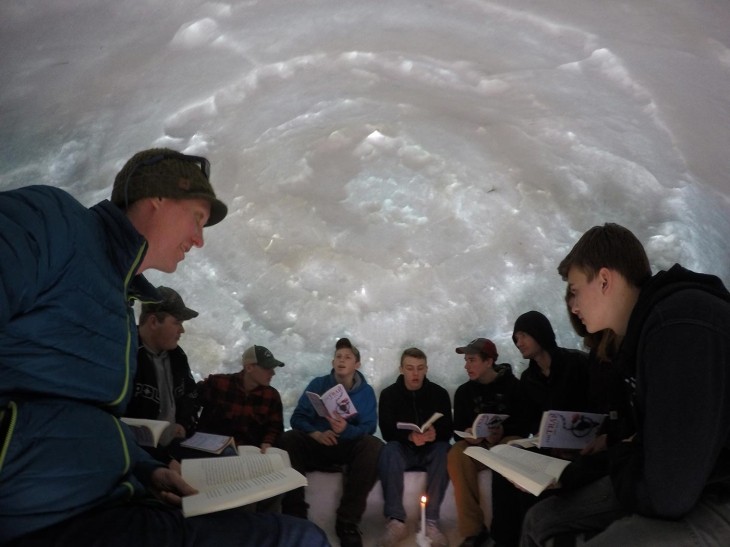
Before he was an outdoor educator, Scott Ellis was a student of the woods and rivers. Now in his fourth year as the Outdoor Program Coordinator at Thetford Academy in Vermont, Ellis teaches a year-long course in environmental studies and leads summer canoe trips down the Connecticut River. As students and teachers begin an academic year amid a pandemic that closed schools across the country last spring, those lessons in teaching in the outdoors are being embraced beyond environmental and outdoor ed.
I grew up in Deerfield, Massachusetts, with a ton of woods around me. It’s a historic town, and my best friend and I would find these abandoned cemeteries with gravestones from the 1700s, and they would have these trees in them that were just ginormous. We would climb these 200-year-old hemlock trees and push each other to see who could get higher. We did the build-forts and throw-mud-at-each-other stuff that kids in the woods do, too. God knows where our parents were, but we were out in the woods.
Summer camp was really big for me. I went to a Mass Audubon camp called Wildwood. I loved it. Catching frogs and herpetology was cool, and that was where I kind of fell in love with learning about the outdoors. At the heart of everything I do with outdoor education, it’s all about observe and inquire. I think that was instilled in me at a really young age in that nature camp setting. It wasn’t always about the answers. It was about what do you notice and what do you ask. And it made it fun. I didn’t know every plant species, but I knew something about them, even if I didn’t know their name. I knew where they grew or some bird that liked to eat their berries.
As I moved from being a camper to being a counselor, it felt really good to start sharing the knowledge that I had gained. I went to Prescott College in Arizona, which is all experiential, outdoor-based curriculum. I was learning so many things and I wanted to share what I learned. I wanted to just get kids outside, and I started with doing outreach-type programs, then discovered you can do outreach and science at the same time. To do a wilderness experience program just for the leadership lessons is great, but if you do a wilderness trip where you learn about forest ecology or fluvial dynamics while you’re rafting, and you do leadership – that’s even better.
At Thetford, I teach a class for 10th-12th graders called Environmental Studies and Outdoor Education. It is a double block, so it is half of their education for an entire school year. It’s interdisciplinary so it’s English, science, and elective rolled into one big class. Pre-Covid that meant I had students from 12 to 3 o’clock every day, so we could go places and do really cool project-based learning projects. In a typical year, right now we’d be starting a unit on apples, looking at dendrochronology and studying the age of apples, and collecting apples and making apple cider, and reading about Johnny Appleseed and putting the history and the English and the science into this one cool project at the end where they would do a big lab. We’re still doing that class this year and adapting it. We’re reading Rachel Carson’s Sense of Wonder right now, and we always read Tom Wessels’ book Reading the Forested Landscape.
They have to learn the alphabet before they can learn how to read the forest. So right now we’re studying tree species. Every day I post a video of me going up to a different tree species and talking about how to identify that species, what it smells like, what it looks like. And students have to find a tree of that species and take a picture of it and post it to the Google classroom. We’re adapting the curriculum and using technology, and the kids are getting it. We’re also crazy fortunate that all of my students have access to great outdoor spaces at home.
Solo time is a key element of our curriculum, too. Silent reflection in the woods by yourself has a lot of power, and a lot of magic can happen. Pre-Covid, each student in my class had a solo spot on campus, and they went there every Friday for at least a half hour. We’re continuing that this year remotely. They actually have to learn how to make a map so they can show their parents exactly where their solo spot is. They’re going to go there every Friday for at least half an hour, and they have some small assignment, but mainly it’s just to sit and be there. They do an overnight in the winter in their solo spot, and at the end of the year, they have a 24-hour experience in their solo spot.
What they learn is not all content, it’s more concept. Nature’s a great place to teach us all sorts of lessons not just about the natural world, but about ourselves and how we interact with others. Using those metaphors of how trees interact with each other, then talking about how we interact with each other, then sitting down and free journaling for a while. I want them to love writing, and I think a lot of kids in high school don’t love it when it’s really structured. Of course, we’re teaching content as well. We’re covering standards and getting that stuff in, but we’re allowed to do it at a little bit of a different pace.
To address safety issues related to Covid-19, this year we’ve created a pretty cool model at Thetford Academy. Students are given the choice to come to school zero days, two days, or four days, and when they are here, they are assigned a pod. That pod has a teacher at the school that may not necessarily be any of their content teachers. We’re still giving them all the curriculum via remote style, like we did before, but with more structure. And now they have a teacher that can help them. What I’ve already noticed is the kids in a pod can help each other with the technology, too.
It’s a ton of outside time. All of the pods have an hour of scheduled time each day in an outdoor classroom. We have a gorgeous timber frame structure that our students built a few years ago, and we’ve put up some temporary tents. At Thetford we’re super fortunate – we have 500 acres, and there are so many great trails. There are about six great 1-mile loops right out the door. The pod teachers are making it the routine to go for a walk at least once a week – but a lot of teachers are doing it every day. It may be content driven, but it might just be let’s get outside and go for a walk. Each pod has a designated lunch spot outside that they don’t share with other pods, and all of these spaces have really good wi-fi, so a class can go there whenever they want. Looking out my window right now, there are kids sitting on the grass working on their computers. They have their masks off because they’re outside.
Outdoor education has been a central theme of what we do at Thetford, but the mandatory scheduled outdoor time is new this year. Some of our teachers have really embraced the outdoor resources that we have. Right now, every teacher is going outside. Some of them are finding out it’s pretty great. They’re seeing the kids react in a different way. After a 20-minute walk, they come back and they’re more focused and they have conversations they might not otherwise have.
My hope is that we can find the positive in the pandemic. And I think one positive is that many educators are embracing the outdoors for the first time. And when the pandemic is over, I think they’re going to take away some of the things we’ve done and bring that to their teaching and realize that we live in a very, very cool place, and it’s an educational tool. The forest is a textbook for us. It teaches so many great lessons.



